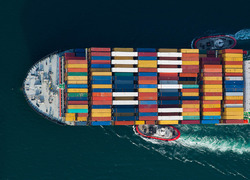Global box volume growth brakes sharply

Latest volume figures paint a glum picture for the container market, as healthy growth from last year fails to spill over into 2019. The effect of the US-Sino trade spat has been telling on the transpacific, which has overshadowed a strong showing on the Asia-Europe trade.
Latest CTS figures show global volume growth at 1.3% in the first six months of 2019 against 4.5% at the halfway mark last year.
VOLUME growth on the major container trades slowed markedly in the first half of 2019 when compared with the previous year, in a worrying trend for carriers ahead of the peak season.
The latest figures published by Container Trades Statistics show carried box numbers at 84m teu through the six months ending June 30, representing a 1.3% increase on the corresponding period of 2018. This compares with a 4.5% growth figure at the halfway mark last year.
Perhaps of more concern is how volume growth in June — often a strong indicator of what lies ahead for container shipping’s coming peak season, which stretches through July to October — came in at a measly 0.9%.
Last year, carriers enjoyed a box bounty on the transpacific route. This helped offset a weak standing on Asia-Europe, which, alongside the transpacific, is the most lucrative of the east-west trades.
Annual figures last year on the Far East-North America trade were up 6.6% on 2017, with healthy US consumer confidence coupled with extraordinary frontloading, as shippers moved to beat the clock ahead of proposed tariffs on Chinese imports in the latter stages of the year, boosting container trade.
In 2019, volumes have so far flattered to deceive, and the impact of the US-China trade is beginning to become evident.
Volume growth in June was up by just 1.3% against the 4.1% growth recorded in 2018, according to CTS. June’s figures too came off the back of two consecutive months of declines, and with-it negative volume growth numbers for the second quarter, down 0.5% on-year. For the full six months, transpacific volumes of slightly over 9m teu only just top last year’s total, rising by a marginal 0.2%.
The bad news is that the trade war escalated further over the past week. The US announced that it would put a small additional tariff of 10% on the remaining $300bn worth of Chinese goods not subject to the existing 25% levy.
Earlier this week, analysts Sea-Intelligence commented that it is unlikely that there will be any “significant volume shift”, as the September 1 implementation date will not provide enough time to prepare alternative sourcing, particularly during the peak season. Frontloading ahead of the latest tariffs is also pretty much out of the question given the time restraints.
Moreover, Sea-Intelligence said the worry, citing political analysts, is that China will respond not with tariffs on US goods, but with restrictions on exports of rare earth materials critical to the US defence and technology industries. This would be achieved by blacklisting certain US companies under a newly established ‘unreliable entity list’, or by issuing export controls of key tech components, said SeaIntel.
The saving grace for carriers has been the Asia-Europe trade, where volumes — again in stark comparison to last year when growth was moderate at best, have ticked along nicely.
CTS figures show that volumes on the east-west trade jumped 5.2% in the first half of 2019 to 8.3m teu. June figures were up 3.8%.
Everything points to a fruitful peak season for Asia-Europe carriers in terms of volumes, however, questions remain as to whether lines can ensure freight rates follow suit.
The latest Shanghai Containerised Freight Index shows average spot rates from China to Northern Europe up until the first week of August down 5.8% last year. While average spot rates are up on China-Mediterranean routes during the same period on 2018 levels, increases are only slight at 1.4%.
The CTS price index on the Asia-Europe route did climb in June to reach 55 points, however, it was still tracking four points lower than the same month last year.
A steady influx of new capacity has kept a lid on rates until now. Indeed, Alphaliner recently highlighted how despite the significant volume gains on the Asia-Europe trade in the first half of 2019, supply has risen at faster rate.
Although carriers have restrained themselves from adding to the forward orderbook, which at around 10% of the existing fleet is at its lowest ebb in years, there is still a healthy number of ships in the 18,000 teu+ size bracket due on the water and many this year.
The lion’s share, or indeed nearly all, of these units will be deployed on the Asia-Europe trade. Carriers have sought to soften the impact with unprecedented blank sailings through the peak season, however, this has still to translate to higher rates.